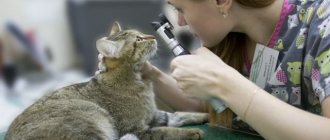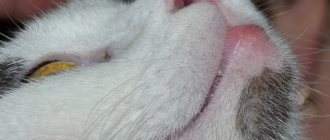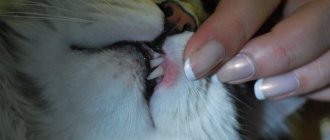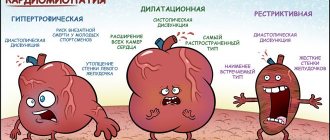PATHOLOGIES OF THE SEXUAL CYCLE AND DISEASES OF THE GENITAL ORGANS.
ANOSTRIA – absence of estrus as a result of congenital or acquired hypofunction (reduced function) of the ovaries. The reason is insufficient production of hormones by the anterior pituitary gland and the thyroid gland. There is pubertal anostria - absence of estrus at 18 months of age, juvenile anostria - if it occurs after the first or second estrus, postpartum - if it occurs after childbirth. If the owner does not intend to produce offspring from his dog, then anostria has no clinical significance and does not need to be treated. Treatment . If you want to get puppies, the veterinarian carries out hormonal therapy with estrogens and gonadotropins. The first estrus passes without ovulation; on the second estrus, after repeated therapy, fertilization can occur. If treatment is ineffective, it is not repeated.
SUBOSTRIA – weakly expressed estrus. It appears at the usual time, but proceeds without swelling of the labia and with copious secretion of mucus from the vagina. Treatment. Conducted at the beginning of estrus, gonadotropins and, if indicated, estrogens are used, 4 days after the last injection the bitch is taken for mating.
PROLONGED HEAT - a syndrome characterized by a violation of the structure of the reproductive cycle; caused by hyperfunction (increased function) of the anterior pituitary gland - excess estrogen. Consequently, prolonged estrus is an endocrine functional disorder associated with morphological changes in the genital organs. There are four types of symptom complexes. Type 1 – extended proestrum period of more than 21 days. Males become excited upon contact. The female's labia are swollen, the vaginal discharge is watery-red, the mucous membrane is swollen and hyperemic (bluish), and the cervix is radially folded. Type 2 – middle-aged individuals also suffer from an extended proestrum period. Males do not get excited upon contact. The female dog has persistent swelling of the labia, slight red-brown vaginal discharge, palpable thickening of the uterine walls, skin itching, symmetrical alopecia, and acanthosis nigricans of the genitalia. Type 3 – extended estrus period of more than 12 days. The symptoms are basically the same as type 2, but the vaginal discharge is mucous rather than bloody, and the skin is not as severely affected. At the same time, pseudolactation, thirst, blood leukocytosis and increased ESR are observed. Middle-aged females suffer. Type 4 – elongated early metoestrum. Bitches are sick at 10-12 months of age, immediately after a normal estrus. Swelling of the labia, serous-mucous or purulent discharge from the vagina appears, the uterus is enlarged, the uterine pharynx is swollen. The dog is lethargic, very thirsty, has no appetite, the coat is dull and disheveled. Treatment depends on the type of disorder and consists of hormonal correction, and, according to indications, antibiotics are prescribed. The prognosis for prolonged estrus of type 4 is favorable, for types 1, 2 and 3 it is cautious, since during hormonal therapy the development of pyometra is possible, so monitoring the blood condition is mandatory! If the blood test and general condition of the dog worsen, removal of the ovaries or uterus is indicated.
PYOMETRA, HEMATOMETRA, ENDOMETRITIS, CYSTIC GLANDULAR HYPERPLASIA OF ENDOMETRIA - these diseases are based on an endocrine disorder, which affects the increase in the level of estrogen in the blood. A constantly high level of estrogen predetermines pathological swelling of the uterine epithelium (endometrium) and leads to changes in the walls of the uterine vessels. The presence in the uterine cavity of nonspecific microflora (Escherichia coli, streptococci, staphylococci), penetrating into the uterus into the metoestrum from the urinary system, complements the pathological effect. The similarity of the symptoms of these diseases allows doctors to identify a symptom complex of uterine damage - endometritis-pyometra complex, which develops within 2 months after estrus and is characterized by copious vaginal discharge, increased abdominal volume, thirst and increased volume of urine excreted (polyuria). The disease occurs in 7-9 year old dogs, somewhat more often in nulliparous bitches. Symptoms. As mentioned above, they are very similar, so let’s focus on the main differences.
PYOMETRA – symptoms increase slowly. Typically, 3-8 weeks after a normal estrus, polyuria and thirst develop, which is associated with hyperfunction of the anterior pituitary gland. At the same time, the abdomen increases in volume, and an enlarged uterine horn is palpated through the abdominal wall. Swelling of the labia and profuse purulent discharge with minor pyometra and the absence of these symptoms with major pyometra. Sometimes signs of intoxication are noted: general weakness, vomiting, disheveled fur (more typical of pyometra minor). Laboratory tests reveal an increase in ESR, leukocytosis, monocytosis, an increase in the blood concentration of urea, createnine and cholyesterase activity, albuminuria.
HEMATOMETRA - often diagnosed as a result of traumatic injury to the pregnant uterus, less often due to dysfunctional uterine bleeding. The disease develops quickly. The bitch's weakness, apathy, and pallor of the mucous membranes increase hourly. The volume of the abdomen increases significantly in 1-2 hours. Blood clots may fall out of the vagina, but they may not exist. The diagnosis is confirmed by laboratory determination of anemia.
ENDOMETRITIS AND CYSTIC GLANDULAR HYPERPLASIA OF THE ENDOMETRIA - a distinctive feature is a wide opening of the cervical pharynx, while other symptoms of the endometritis-pyometra complex are weakly expressed. Vaginal discharge is more reminiscent of a prolonged estrus. Cystic glandular hyperplasia of the endometrium is additionally indicated by tuberosity and tenderness of the walls of the uterine horns, as well as eosinophilia. The diagnosis is made by excluding other diseases after laboratory examination. The prognosis for hematotra with timely treatment is favorable. With pyometra, the outcome is predicted by the concentration of creatinine in the blood - from cautious to hopeless. Endometritis and cystic glandular hyperplasia of the endometrium are not life-threatening for the dog, but are dangerous due to the possible development of pyometra. Treatment is carried out only by a veterinarian. For endometritis and cystic glandular hyperplasia of the endometrium, hormonal drugs are selected, and for hematometra and pyometra, the only radical method is to remove the uterus (ovariohysterectamia).
PART 2
Infertility.
Infertility in a bitch is said to mean a lack of fertility, despite repeated fertilization, or a sharp decrease in the number of live puppies in the litter compared to the average number characteristic of a given breed.
Causes:
1. Untimely fertilization of the bitch without taking into account individual variations in the structure of estrus. The owner needs to know the sexual cycle of his dog and bring it for mating in a timely manner;
2. Increased amount of microflora in the female genital tract. Determined by bacteriological analysis by taking vaginal smears. Treatment is carried out with antibiotics 2 weeks before the expected date of estrus;
3. Slow breakdown of estrogen in the female’s body. See Prolonged estrus in part 1;
when using a regular sexual partner, the reason may be the pathological state of the sperm. It is recommended to change the male dog and preferably undergo a bacteriological analysis.
False puerility (Pseudo-lactation).
This is a complex of physiological and mental disorders in the female body, which manifests itself 4-9 weeks after estrus. Let us immediately note that age, breed and number of puppies do not play a role in the occurrence of this painful condition. The appearance of the pathology is due to the delay of the corpus luteum with the preservation of its activity characteristic of pregnant and lactating animals, which is associated with a violation of ovarian trophism and a decrease in their function.
Symptoms – swelling of the mammary glands with low or high lactation; the bitch shows concern, looks for secluded places where she builds a den; tears upholstered furniture; assumes the pose of a nursing mother; places toys, slippers, etc. under nipples; goes for a walk reluctantly, always trying to go home; can show aggression, defending the den and “puppies”.
Treatment . If the disease occurs in the form of mild lactation, without the symptoms listed above, then no special treatment is required. You should reduce your drinking, eliminate dairy products from your diet, and increase your walks. In case of strong lactation (do not express milk!) and the severity of the symptom, treatment is carried out. Testosterone propionate is administered 2 times a week for 2-3 weeks (Attention! Hormonal drug! Use after consultation with a veterinarian). For very strong lactation - furosemide 1-2 mg/kg every other day 5-6 times. Bromcamphor (or bromocriptine) is given with food, 1 tablet 2 times a day, for 10-17 days. Be sure to put the dog on a low-calorie diet (porridge + vegetables), limit drinking, and exclude milk and dairy products. Try to increase physical activity.
Normal pregnancy.
Soon after fertilization, the dog's metabolism changes and the body's need for energy increases 4 times, a good appetite appears, the coat becomes smooth and shiny, and the body shape is rounded. In the second half of whelping, day 35-40, the bitch begins to lose weight, and her appetite increases. During the period of rapid development of the fetus, the mother's blood calcium level sharply increases, so it is necessary to introduce calcium supplements and cottage cheese into the diet.
Determination of pregnancy periods:
4 weeks - ampulle-shaped expansions in the uterus are palpated;
6 weeks – X-ray reveals the bones of the skull and ribs of the fetus;
7 weeks – individual fetuses in the uterus are palpated;
8 weeks – fetal heartbeat can be heard.
Pathologies of pregnancy.
Abortion is the termination of pregnancy that occurs spontaneously or as a result of pathological effects on the mother’s body. According to clinical manifestations, abortions are classified into complete (expulsion of dead and non-viable fetuses), incomplete (mummification or maceration of fetuses) and hidden (embryonic mortality) abortions.
According to etiology, abortions are classified into non-contagious, infectious and invasive abortions. Non-contagious abortions can be traumatic and idiopathic, or result from exposure to poisons and drugs.
Traumatic abortion is caused by bruises of the abdominal wall, blows to the head, as well as stress, thermal and chemical effects, and long-term transportation.
Idiopathic abortion is caused by the development of abnormalities in the fetus and pathologies of the membranes. It is believed that this type of abortion is caused by genetic inferiority of gametes (sex cells), or poor quality feeding.
Contagious abortion can be of bacterial, viral, protozoal and mycotic origin. The diagnosis is made after isolating the pathogen in the laboratory.
Hidden abortion is characterized by the death of all embryos at the embryonic stage. Normally, about 10% of embryos in a dog experience embryonic death. The death of embryos and embryos is possible during critical periods of their development, for example, during the release of the membrane of the fertilized egg or at the time of implantation of the embryo into the uterine wall (21-22 days after fertilization) and at the time of formation of the placenta.
Among the many reasons, the main ones are considered to be genetic incompatibility of gametes, incompatibility of proteins and immunological processes, untimely fertilization, inadequate function of the corpus luteum, vitamin E deficiency, and the presence of pathogenic microflora (mainly coccal forms) in the uterus.
Symptoms of fetal expulsion are no different from childbirth. A concomitant sign of an ongoing or incipient abortion is abnormal vaginal discharge. In non-infectious abortion, vaginal discharge usually appears only after the abortion of the fetuses. In case of infection, the discharge has a putrid odor. In case of poisoning and severe injuries, there may be bleeding from the vagina. Treatment. It is no longer possible to stop an abortion that has occurred! Abortions due to infections, infestations and poisonings cannot be prevented; therapeutic efforts are directed towards treating the bitch. If there is a threat of traumatic abortion or in animals with congenital hormonal disorders, hormonal therapy is carried out by a veterinarian.
Persistence of fruits. Post-gestation of fetuses beyond 72 days of pregnancy with the appearance of dark green discharge from the birth canal is referred to as intrauterine fetal death syndrome. This condition can sometimes last up to several months without causing a reaction in the bitch’s body. Under the influence of putrefactive microflora, the fruits undergo maceration (decomposition). They can be easily palpated through the abdominal wall. In the absence of putrefactive microflora, fruit mummification occurs. The prognosis is favorable for the bitch. Treatment is surgical.
Puppy and pyometra. They occur in a bitch with symptoms characteristic of pregnancy, with one uterine horn filled with fetuses and the other with exudate. This combination is detected only during laparotomy, which is performed due to a sharp deterioration in the dog’s condition: depression, disruption of labor, etc.
The prognosis is favorable. A caesarean section is performed while the puppies are alive, followed by removal of the uterus.
Inversion of the horn of the pregnant uterus. An acute traumatic condition consisting of mechanical rotation of the horn of the pregnant uterus around the longitudinal axis by 360 degrees. with twisting of the supply vessels. The injury occurs shortly before birth and is associated with a disproportionate increase in the mass of the uterus in relation to the strength of the uterine ligaments. Injury can also occur with pyometra and neoplasms in the uterine wall. Symptoms: sudden change in the general condition of the dog, tense abdomen, frequent weak pulse, pallor of the mucous membranes, increasing depression and weakness. Notably after 6 hours, hemodynamic shock develops. Treatment is only surgical. Without diagnosis and treatment, the outcome is fatal.
To be continued
Information for pet owners.
Definition.
Hydrometra in dogs is the accumulation of serous fluid in the uterine cavity, and mucometra is the accumulation of mucus. As a rule, upon microscopic examination, the contents are small-celled and sterile. Hydrometer in dogs is determined at a certain phase of the reproductive cycle or with cystic endometrial hyperplasia. It is believed that a hydrometer or mucometer is one of the constituent signs of a “false pregnancy.”
Clinical picture.
The main reason for pet owners to visit the clinic is disruption of the normal course of the reproductive cycle, false pregnancy. In this case, dogs are diagnosed with: refusal to eat, cachexia, care for toys, swelling of the mammary glands, and an increase in the volume of the abdomen.
Causes.
In most cases, the accumulation of fluid in the uterine cavity is associated with a violation of its outflow. Outflow disturbance can be pathological (due to cystic hyperplasia, cervical tumor, polyps of the uterine wall) and physiological, during a certain stage of the reproductive cycle.
Diagnosis.
To make a diagnosis, it is necessary to take into account the animal’s medical history, conduct an examination and conduct laboratory and instrumental research methods. As a rule, disturbances in the cyclicity of sexual activity in dogs are a reason to suspect hydrometra. During the examination, the doctor determines a moderate or significant increase in the body of the uterus. Eliminates diseases of the external genitalia. The ultrasound method is key to making a final diagnosis. Ultrasound is used to determine the size of the uterus and ovaries. A sign of hydrometry is the anechoicity of the uterus and an increase in diameter (Figure 1).
Figure 1. Ultrasound of the dog's uterus. Anaechogenic contents in the uterine cavity were noted.
Treatment and prognosis.
Treatment methods directly depend on the cause of the disease. High-breed dogs are recommended to be treated conservatively - hormone therapy. If the root cause in dogs is tumor processes, then surgical treatment is recommended, which includes removal of the uterus and ovaries. Intraoperatively, the surgeon detects an increase in the size of the uterus and a loose uterine wall (Figure 2). Sometimes tumors are removed simultaneously.
The prognosis after removal of the pathological uterus and ovaries is favorable. If during the diagnostic process tumor changes in the reproductive organs are determined, the prognosis depends on the type of tumor.
What is pyometra and why does it occur?
In simple terms, pyometra is an infection of the uterus. Pyometra is considered a serious and life-threatening condition that must be treated promptly and aggressively.
Pyometra is a secondary infection that occurs due to hormonal changes in the female reproductive tract. For several weeks after a heat, progesterone levels remain elevated, stimulating the lining of the uterus to thicken in preparation for pregnancy. If pregnancy does not occur within several heat cycles, the uterine lining continues to enlarge until a cyst forms. This condition is called cystic endometrial hyperplasia. The cystic lining of the uterus secretes fluid, which creates an ideal environment for bacteria to multiply. In addition, high levels of progesterone inhibit the ability of the muscles in the uterine wall to contract and push out accumulated fluid or bacteria. Another contributing factor is that during estrus, white blood cells, which normally protect the uterus from infection, are blocked from entering the uterus. This is normal and allows sperm to pass safely through the female's reproductive tract without being damaged or destroyed by white blood cells. The combination of these factors often leads to infection.
To sterilize or not? That is the question... Or the story of one Hydrometers
In recent years, the number of cats kept as pets has increased significantly. And in this regard, their owners have more and more questions regarding maintenance and care.
One of the most frequently asked questions among owners is: “Is it worth sterilizing a cat and what is it for?”
Based on my own experience and statistics provided over the years of practice by colleagues, I came to a clear conclusion. Sterilizing cats is a MUST! Unless, of course, you purchased the animal for breeding purposes. Moreover, it is advisable to carry out sterilization (or ovariohysterectomy) at a young age, while the animal is physiologically healthy and has no associated pathologies. Because the use of anesthesia in elderly animals with any pathologies poses great risks and sometimes even a threat to life.
Now I would like to move on to a description of a clinical case. During one of my shifts, I received a cat who was sent for an abdominal ultrasound from another clinic due to the fact that her abdomen was greatly enlarged.
The life history indicated: depressed state, lack of appetite for 2 days, single vomiting of white foam, unformed stool. Upon examination it was discovered: mucous membranes are pink, breathing is rapid; body temperature 38.9 C; on palpation, the abdominal wall is tense, painful, the abdomen is greatly enlarged in size (according to the owners, the volume of the abdomen increased over the course of 6 months). Blood tests were taken to monitor the condition. An abdominal ultrasound revealed a deviation from the reproductive system. It was terrifying.
As can be seen in the photographs provided, the cat’s uterine horns were greatly increased in size. The lumen was filled with anechoic contents (liquid) and the diameter of each horn reached from 3 to 5 cm, which indicated that the process was neglected and the need for emergency surgical intervention to avoid uterine rupture and subsequent peritonitis. Fortunately, other organs were without pathologies. According to the ultrasound data, a preliminary diagnosis was made: hydrometer.
Hydrometra - accumulation in the uterine cavity of the secretion of the uterine glands, transudate, mucous-catarrhal exudate. Hydrometra is a possible consequence of chronic endometritis. A large amount of fluid accumulates in the uterine cavity. The walls of the uterus can be stretched, thinned, and thickened in the area of scars and adhesions. The uterus and ovaries are lowered into the abdominal cavity. The ovaries are cystic or contain a persistent corpus luteum. The general condition of the animal is usually unchanged. There are no sexual cycles. If the cervical canal is not completely closed, periodic discharge from the uterus is possible.
Based on these data, without waiting for the results of a blood test, an emergency ovariohysterectomy (complete removal of the organs of the reproductive system, including the ovaries and uterus with contents) was performed. Fluid from the uterine cavity was sent for cytological examination.
After which, the cat was left in an intensive care hospital. The day after the operation, with blood tests in hand, the appointments were adjusted.
Receiving daily treatment (in the form of infusion therapy, antibiotic therapy, antioxidants, immunomodulators that accelerate tissue regeneration processes), the cat recovered quite quickly. Appetite also normalized, stools became formed, and activity appeared. On the third day she was already discharged home for outpatient treatment. A week later, an analysis was ready for a cytological examination of the contents of the uterus, in the conclusion of which it was indicated that it was: a fluid containing protein and low cellularity, cells with severe degenerative changes, the smears contained vacuolated macrophages and squamous epithelial cells located against the background of structureless detritus. Based on this conclusion, a diagnosis was made of a cystic formation (cystic endometrial hyperplasia). This meant that the preliminary diagnosis was confirmed. After 10 days, at the re-appointment when examining the cat, there was not the slightest sign of a pathological process. The cat behaved actively, had an excellent appetite, and problems with stool disappeared. The animal has fully recovered. A month after the operation, at a follow-up appointment, no pathologies were identified, deworming was carried out, and after another 2 weeks, an absolutely healthy and cheerful cat was vaccinated. The owner, having experienced an unpleasant experience, came to the conclusion that if she gets another cat, she will definitely sterilize it at a young age, which will protect her pet from such serious health problems, and the owner herself from incredible experiences and, not least important , serious material costs for treatment.
Unfortunately, I would like to note that not all cases of endometritis end so well. And to summarize the above, I would like to say that most diseases are easier to prevent than to treat.
Sincerely, veterinary therapist
Branch of Rechnoy Vokzal and New Cheryomushki
Shmachkova Maria Alekseevna!
Diagnosis of pyometra in a cat
As a rule, the doctor will suggest approximately the following algorithm:
1. Collection of information about the life history and disease of the animal.
2. Clinical examination of the animal.
3. Blood test: In a general clinical blood test, an increase in neutrophilic leukocytes is determined, which indicates inflammatory processes in the body.
In blood serum:
- hyperglobulinemia or increased total globulin levels. Their concentration increases during dehydration, inflammatory processes in damaged tissues, as a response to the action of foreign agents.
- hyperproteinemia or increased levels of total protein as a result of dehydration, acute or chronic infectious process.
- azotemia – increased levels of protein metabolism products (urea, uric acid and other substances) in the blood. This is a sign of kidney disease or tissue breakdown, for example, with purulent inflammation in the uterus.
- increased activity of the enzymes alanine aminotransferase and aspartate aminotransferase. This indicates severe dehydration, problems with the heart and liver.
4. Examination of vaginal discharge.
Bacteria and leukocytes are detected in a cytological smear. Leukocytes are the first to appear at the site of inflammation, capture and neutralize microorganisms, and contribute to the “recycling” of dead tissue.
Bacteriological research: identification and determination of the culture of opportunistic microorganisms, identification of their sensitivity to antibacterial drugs.
5. X-ray: purulent effusion in the uterine cavity is visible on the image as an oblong formation in the lower abdomen.
6. Ultrasound diagnostics helps to reliably establish the fact of enlarged uterine horns and the presence of fluid in it. Normally, the wall of the uterus is not visible on ultrasound.
Differential diagnosis of pyometra in a cat:
- pregnancy: its signs are clearly visible on an x-ray one and a half months after ovulation.
- other conditions in which polyuria and polydipsia develop, for example, kidney pathologies, diabetes mellitus, diseases of the endocrine system;
- inflammation of the vagina.
Causes and symptoms of the disease
The most common cause of pyometra is increased production of the hormone progesterone in females of reproductive age. This disorder is characterized by the production of mucus in the uterine cavity, and under the influence of excess progesterone, local immunity is reduced. Mucus begins to accumulate in the diseased organ, and pathogenic bacteria multiply, leading to purulent inflammation. Often the cervix closes, preventing pus from being drained out.
Often the infection enters the body after childbirth or during estrus, when the conditions for its development are ideal: an open cervix, reduced immunity, hormonal changes. It happens that infection occurs due to failure to maintain sterility during childbirth. Hormonal medications for pregnancy containing estrogens significantly increase the risk of the disease. If your pet has inflammation, which is accompanied by the release of pus, then it can also cause pyometra.
The following categories of dogs are most at risk of contracting this disease:
- age more than five years;
- the sterilization procedure was not carried out;
- the pet has never given birth;
- frequent childbirth after each heat;
- the animal receives an unbalanced diet;
- the pet is walked less than twice a day, a sedentary lifestyle;
- excess weight;
- cases of false pregnancy.
Signs of pyometra
There are two forms of the disease: open and closed. The open form can be diagnosed by the following signs:
- The animal often drinks water due to intoxication of the body.
- Increased body temperature.
- Poor appetite.
- Lethargic state - the bitch is reluctant to go for a walk, she lies or sleeps more.
- Swelling of the loop.
- Discharge from the dilated cervix, which can be either abundant (the animal leaves drops on the floor and bedding) or scanty (then the dog often licks up). They are usually grayish-green in color with blood clots.
- Malfunction of the gastrointestinal tract, diarrhea, vomiting, nausea.
The closed form is characterized by:
- first, body temperature can rise to 40 degrees, and then drop below normal;
- frequent urge to go to the toilet, but little or no urine;
- due to high temperature there may be cramps, unsteady gait, muscle pain;
- refusal of food;
- painful sensations in the abdominal cavity; when you touch it, the dog begins to whine or does not allow you to touch it;
- abdominal swelling may be observed (owners may attribute this to overeating or pregnancy);
- apathy, lethargy, reluctance to go for a walk.
In this case, pus accumulates in the uterus and the disease develops quickly and acutely. If the dog is already old and obese, then the symptoms are not always immediately noticeable, then the walls may rupture and pus will spill into the abdominal cavity.
If such symptoms are observed, you should immediately contact a veterinarian, because during an exacerbation the animal dies within a few days or even hours. During a home examination, you should be very careful when palpating the abdominal cavity, because rupture of the walls of the uterus may occur, and this is very dangerous.
Diagnosis
When contacting a veterinary clinic, the doctor will ask in detail about deviations in behavior, the date of the last estrus, pregnancies, etc. Next, an examination of the abdominal cavity is carried out, which shows the degree of enlargement of the affected organ. A swab is taken from the loop, as well as urine and blood tests. The most accurate diagnostic method is x-ray and ultrasound examination. The image clearly shows the size of the uterus, which can be used to determine the degree of complexity of the disease.
Only a doctor can say with certainty whether a dog has pyometra: symptoms and treatment are individual and may vary slightly depending on the severity of the disease and the characteristics of the animal.
Hemometra in dogs
Dogs are sometimes diagnosed with hemometra, or hematometra, a condition where the uterus fills with blood rather than pus. The cause is usually traumatic injury to the uterus in a pregnant bitch. The symptoms are similar to those with pyometra, only blood with clots flows from the vagina. If you suspect a hemometra, you should immediately consult a doctor. Ovariohysterectomy (sterilization) is prescribed for treatment.
Causes of pyometra in cats
The cat's uterus has two horns that connect into a short body. Adjacent to it is the cervix, which passes into the vaginal vault.
The wall of a cat's uterus consists of mucous, muscular and serous layers.
In the mucous membrane of the uterus or endometrium there are special cells that secrete a secretion that protects the mucous membrane of the genital tract from the action of various pathological factors. The amount of secretion depends on the stage of the reproductive cycle; for example, less is secreted between heats. The secretion moves towards the vagina due to contraction of the uterine wall. Normally, the uterine cavity should not contain free fluid, with the exception of membranes during pregnancy.
The development of pyometra in a cat can be influenced by several interrelated reasons:
1. Opportunistic microflora: streptococci, staphylococci, E. coli and other microorganisms that enter the uterine cavity through the cervix from the vagina. The cervix opens partially before and during ovulation. This causes purulent inflammation of the uterine mucosa or purulent endometritis. In this case, the lumen of the cervix narrows sharply due to thickening of the mucous membrane. As a result, the removal of inflammatory effusion is impaired. The contents fill the uterus, sometimes significantly increasing the volume of the organ.
2. Changes in the mucous membrane:
- purulent endometritis, as a result of the action of various pathological factors
- acute postpartum endometritis
- endometritis as a consequence of abortion. Abortion in an animal is an interruption of pregnancy in which the embryo is completely or partially resorbed in the uterus, or the fetus is expelled from the uterus. Sometimes the fruit may decompose.
- endometritis, as a result of hormonal changes. Normally, after the release of a mature egg from the ovary (ovulation), female sex hormones are produced that prepare the endometrium for pregnancy. In the absence of pregnancy, the effect of high doses of sex hormones leads to changes in the endometrium. Hormonal imbalances may result from disruption of internal organs or from the use of drugs that stop ovulation.
3. Other reasons:
- pathological birth
- incorrect assistance during childbirth
- atony (lack of tone) or hypotension (decreased tone) of the uterine wall
- infectious and invasive diseases
- previous illnesses
- scars, fusion of the cervical canal
- pelvic bone injuries
- malignant neoplasms that cover the cervix and are a source of bacteria during tumor decay
Treatment methods
There are two methods of treating pyometra: medication and surgery.
Treatment of pyometra in dogs without surgery is prescribed only in the early stages of the open form of the disease. It is very difficult to diagnose the disease at the very beginning; as a rule, there are no alarming symptoms. And only tests before mating or a routine medical examination can reveal the disease.
During drug treatment, a course of antibiotics and hormonal agents is prescribed, which contract the uterus to remove pus. But such treatment is not always successful: it weakens the pet’s immune system, and if a relapse occurs in the future (and this very often happens after the first or second heat), then the body does not have the strength to fight the disease. Sometimes certain medications can cause rupture of the walls, which subsequently leads to the leakage of pus into the abdominal cavity and peritonitis.
If drug treatment does not give a good result, time will be lost. Therefore, veterinarians prefer surgical intervention, when the uterus with pus and the ovaries are completely removed. This operation is called ovariohysterectomy. Most often it is performed under epidural anesthesia (into the spine through a catheter), which is safer than other types of anesthesia. If you leave the ovaries or stump, complications may arise. Of course, this method makes it impossible to give birth to offspring in the future, but this is the only way to save the animal’s life, especially with a closed form of the disease.
Even if drug treatment was successful, the likelihood of becoming pregnant in the future is extremely low. If this happens, then the offspring is born weak. Therefore, it is better for owners not to insist on preserving reproductive function, but to do everything to preserve the life of their four-legged friend.
In rare cases, if the animal is weak and old, it is better to euthanize.
You should not touch or try to treat your pet yourself: only a specialist can conduct the necessary research and prescribe a course of treatment.
After surgery, the dog is prescribed antibiotics to help suppress the source of infection. Usually the animal feels well on the second day after the procedure.
Treatment of pyometra in a cat
If the cervix is closed, pyometra is life-threatening; it is necessary to urgently contact a veterinarian. Regardless of the dilatation of the cervix, removal of the uterus and ovaries is indicated.
Drug treatment is carried out to preserve reproductive function in animals. Hormone therapy and antibiotic therapy are indicated. Treatment is carried out in courses, sometimes for a long time. The danger of this method is the possibility of relapse of pyometra and the side effects of drugs.
We can talk about the effectiveness of treatment if the size of the uterus is close to normal and the general condition of the cat improves. In this case, discharge from the uterus can persist for up to 4 weeks.
If treatment is successful, experts recommend immediately allowing the cat to be bred, since the endometrium during pregnancy is less susceptible to infection. At the end of pregnancy, remove the uterus.
Postoperative care
After recovering from anesthesia, the dog walks poorly for one or two days, movements are uncoordinated, and reacts poorly to external stimuli. She may refuse to drink or eat, and may vomit. Don't be afraid of this, this behavior is quite normal. But also a lot depends on the age, breed and size of the bitch.
Sometimes postoperative complications appear, such as kidney failure, stomach upset, and fever. Then the veterinarian prescribes additional medications.
During the postoperative period, the pet must wear a special bandage, which is removed only for treatment and ligation of sutures. After a few days, a fibrous adhesion forms around the wound, which will resolve over time. During this period, it is especially important to monitor the dog’s hygiene.
The animal must have 24/7 access to fresh water. It is especially important to choose the right diet. It is best to buy special premium food for sterilized animals in stores. The dog will be able to return to its normal diet in approximately six months. In addition, you need to buy special supplements and vitamins to strengthen your immune system.
As a rule, after 2-3 weeks the dog returns to its usual lifestyle, the stitches heal, and the appetite is restored.
How to care for your cat after pyometra removal
After the operation, if it was not complicated by ruptures and sepsis, the animal usually recovers quickly. Intradermal sutures do not require removal or special treatment, and if regular sutures were applied, they will need to be washed with special antiseptic agents until the threads are removed.
After the operation, the cat will have to wear a special blanket for about two weeks.
Literally after 7-10 days of course of rehabilitation therapy and wearing a blanket, the cat will be healthy. Such operated animals live for quite a long time. On any forum of pet lovers there is a lot of evidence of this - reviews from grateful owners and photos of rescued animals.
Prevention
The best way to ensure that your pet never gets pyometra is sterilization. But not all owners agree to such a radical step. If you are also against it, you should adhere to several rules:
Firstly, you need to regularly take your pet for examinations to the veterinarian for early diagnosis of diseases.
Secondly, pyometra is often caused by taking hormonal contraceptives to suppress estrus in females, so it is best to avoid them.
Many dog experts recommend limiting your dog's food and water intake, as well as eliminating dairy products from the diet for two months after estrus. A balanced diet rich in vitamins and minerals, as well as good physical activity, is also important.
To avoid infections, it is better to protect the animal from contact with stray dogs and cats, especially during the period of estrus, when the cervix is dilated. If a dog gives birth, everything must be sterile, and the bedding must be changed afterwards. After giving birth, even if there are no abnormalities, it is better to be examined by a veterinarian.
Routine examinations should be carried out regularly if the bitch has never given birth, or, conversely, gives birth after each heat, as well as when she reaches the age of six.
If any discharge or discomfort occurs, you should immediately contact your veterinarian and never self-medicate.
Causes of the disease
Inflammation of the uterus in a cat most often occurs after the age of five. Any animal that has not been sterilized is at risk. Thus, the risk of disease exists both in domestic cats that sit indoors and in cats that lead a free lifestyle.
Pyometra in cats is a dangerous disease that can be fatal in the absence of qualified help.
The main causes of the disease are:
- sexually transmitted infections;
- various hormonal imbalances;
- diseases of the ovaries and the reproductive system as a whole, inflammatory processes of the genitourinary system;
- uncontrolled use of drugs that suppress estrus (in cats they lead to changes in hormonal levels and uterine tissue);
- childbirth that occurred with complications, unskilled obstetrics, when injuries were caused during childbirth;
- prolonged presence in the uterus of an unborn placenta;
- prolonged presence of unborn dead fetuses in the uterus;
- all sorts of disorders of the immune system, vitamin deficiencies, weakening of the body’s protective functions.
Early diagnosis of the disease gives a chance for drug treatment without surgery
Main symptoms of pyometra
Typically, the main symptoms of the disease appear approximately 1.5-2 months after estrus, but in some cases we can talk about several days or several months.
There are open and closed forms of the disease. Even the open form, due to the special cleanliness of cats, is sometimes difficult to diagnose, since the animals constantly lick their genitals. But with a more thorough examination of the bedding and furniture, you can see the most important sign of an incipient disease - droplets of pus.
Medicinal treatment without surgery
When diagnosing pyometra in cats, its treatment without surgery is possible, although recently this has been considered ineffective. The method consists of attempting non-surgical intervention with the help of hormonal drugs, antibiotics and symptomatic therapy to cleanse the uterine cavity of the pus accumulated in it.
Hormonal drugs are usually prescribed to block the effect of the hormone progesterone on the uterus (for example, alysine).
Treating pyometra without surgery is a rather risky and expensive method. It is usually used for early detection and uncomplicated course of the disease, as well as in cases where we are talking about purebred and expensive cats from which they are still planning to get kittens. But it should be remembered that even in the case of a positive outcome of the disease, the cat may remain infertile.
Treating pyometra with medication is quite risky; the disease can recur at any time
If the cat’s uterus has not been removed, then after complete recovery and a course of restorative therapy, provided that the histology performed is normal, veterinarians advise not to delay mating the animal in order to produce offspring. After all, there are no guarantees that the disease will not recur and this time urgent sterilization will not be required.
Among the folk remedies prescribed for pyometra, chamomile, calendula, and nettle are usually used. But decoctions of the listed herbs in no case can act as the only and independent remedy for the disease. They are taken along with the main treatment (medical or surgical), and their main functions are to help relieve pain and inflammation, as well as restore the structure of damaged tissues.











